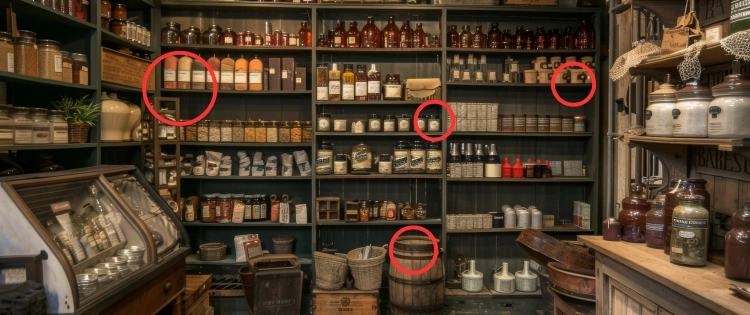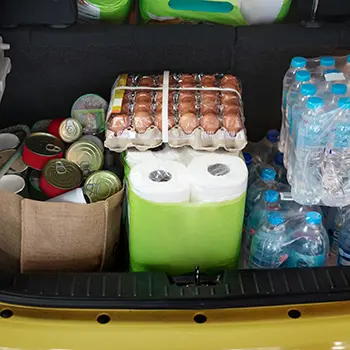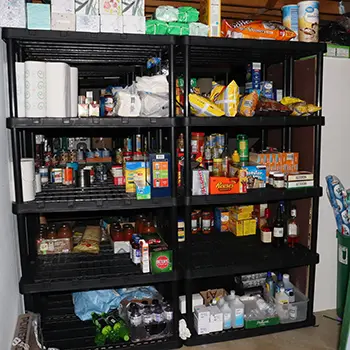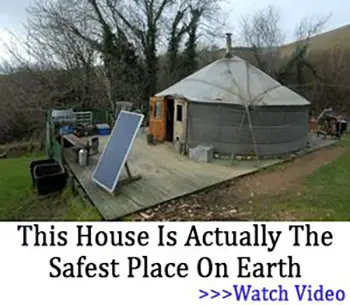When disasters strike, one of the most concerning issues often stems from those with ill intent.
Looting and theft tend to become prevalent as societal structures break down, posing a significant risk to prepared individuals and groups.
In today’s article, I will guide you through effective strategies to deter potential looters and keep your stockpile secure.
Why Worry About Looting?
There are several reasons why looters might target stockpiles during emergencies:
- Desperation for food, water, and other essentials: When resources become scarce, some individuals may resort to looting out of sheer survival instinct.
- Lack of law enforcement presence: In major crises, police and security forces may be overwhelmed, creating a breakdown in law and order.
- Opportunity presented by chaos and societal breakdown: Looters may exploit the disorder and confusion to take advantage of vulnerabilities.
While concerning, the threat of looting is not inevitable. By taking proactive steps, you can significantly reduce the risk and protect your valuable stockpile.
Location, Location, Location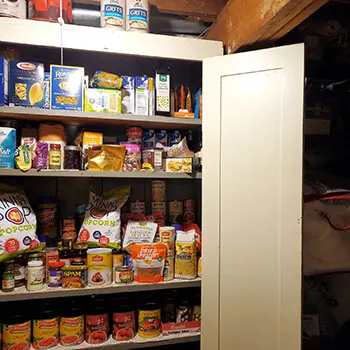
Choosing the right location for your stockpile is crucial in deterring potential looters. Here are some key considerations:
- Avoid easily accessible areas or those with high visibility: Stockpiles in plain sight or in heavily trafficked areas are more susceptible to being targeted.
- Consider natural camouflage or blending in with surroundings: Utilize features like vegetation, terrain, or existing structures to conceal your stockpile location.
Additionally, the decision between an urban or rural setting presents its own set of pros and cons.
Urban areas may offer more security measures but also higher population density and potential for looting.
Rural locations can provide more privacy but may be more isolated and harder to defend.
Physical Security Measures
Implementing robust physical security measures is essential for deterring and preventing looters from accessing your stockpile. Consider the following:
Strong Barriers
- Reinforcing doors and windows: Use heavy-duty materials like steel or reinforced concrete to fortify entry points. Consider adding deadbolts, strike plates, and other reinforcements to doors.
- Adding secondary barriers like fences, bars, or security gates: Create additional layers of security around your stockpile location with fencing, grating, or gates.
Locks and Security Systems
- High-quality deadbolts and security locks for entry points: Invest in reliable, tamper-resistant locks to secure doors, windows, and other access points.
- Considering alarm systems (monitored vs. unmonitored): Alarm systems can act as a deterrent and alert you or authorities to potential breaches. Evaluate the pros and cons of monitored vs. unmonitored systems based on your needs and budget.
Creating a Safe Room (Optional)
For an additional layer of security, you may consider creating a dedicated safe room or fortified space within your stockpile location.
This can serve as a last line of defense for your most valuable or essential supplies. Building or fortifying a safe room requires careful planning and consideration of factors like construction materials, ventilation, and access points.
Utilizing Natural Camouflage
Nature itself can be a powerful ally in concealing your stockpile. Strategically positioning your supplies amidst dense vegetation, rugged terrain, or existing structures can help them blend into the environment.
This approach not only obscures the stockpile from casual observers but also complicates detection efforts for those actively seeking your resources.
Consider the following tactics:
- Vegetation Concealment: Utilize thick foliage, bushes, or trees to create a natural barrier and obscure the stockpile from view.
- Terrain Masking: Position your stockpile in areas with undulating terrain, hills, or depressions that break up the line of sight and provide natural cover.
- Existing Structures: Repurpose existing outbuildings, sheds, or even underground structures to discreetly house your supplies, blending in with the surroundings.
By carefully selecting a location that offers natural camouflage and seclusion, you can significantly reduce the risk of your stockpile being detected, deterring potential looters before they even become aware of its existence.
Maintaining a Low Profile
Whether you’ve chosen to bug out or remain sheltered in place, the adage “out of sight, out of mind” holds true.
Maintaining a low profile and avoiding unnecessary attention is crucial. Imagine being the sole residence on a darkened street with lights emanating from your home, perhaps even the aroma of a grill wafting through the air.
Such overt signs of habitation essentially advertise your presence, potentially attracting unwanted visitors driven by desperation or malice.
Depending on the nature and severity of the crisis at hand, minimizing contact with others may be the prudent course of action for you and your fellow survivors. This approach not only helps conceal your stockpile and resources but also mitigates potential conflicts or dangerous encounters.
- Avoid unnecessary displays of wealth or preparedness: Refrain from boasting or flaunting your stockpile, as this can draw unwanted interest.
- Be cautious about sharing on social media or with acquaintances: Exercise discretion when discussing your preparedness plans to minimize the risk of information falling into the wrong hands.
Community and Collaboration
While securing your stockpile is crucial, forming connections and collaborating with others in your community can provide additional security and resources.
Strength in Numbers
- Benefits of working with trusted neighbors for collective security: By joining forces with trusted individuals or groups, you can establish a more robust security system through shared resources, patrols, and communication networks.
- Establishing a watch system or communication plan: Coordinate with your community to set up a system for monitoring potential threats and maintaining open lines of communication.
Barter System (Optional)
Depending on the severity and duration of the emergency, a local barter system can be beneficial for acquiring essential goods and services:
- Creating a local barter network: Establish a trusted network within your community to facilitate the exchange of resources, skills, and labor.
- Building trust and cooperation: Foster trust and cooperation among community members to ensure the sustainability and fairness of the barter system.
Insurance Options
While not a substitute for physical security measures, exploring insurance coverage for emergencies and potential looting can provide an additional layer of protection. Research policies or riders that may cover losses due to theft or civil unrest.
Focus on Self-Reliance
Ultimately, the goal of preparedness is to minimize dependence on external resources.
Prioritize building a well-rounded stockpile that covers essential needs like food, water, medical supplies, and other necessities to increase your self-sufficiency.
Legal Preparedness
It’s crucial to understand the legal boundaries within which you can operate to protect your stockpile while avoiding potential legal consequences.
Familiarize yourself with local laws and regulations regarding self-defense, property protection, and the use of force.
Consult with legal professionals or relevant authorities to ensure compliance and avoid any actions that could potentially expose you to civil or criminal liabilities.
Additionally, stay informed about any changes or updates to relevant laws, as they can vary based on location and evolving circumstances.
The Survival Mindset: Prioritizing Safety and Well-Being
At the core of preparedness lies a fundamental commitment to safeguarding your safety and well-being, as well as that of your loved ones.
While the threat of looters is a harsh reality, it’s essential to approach the situation with a level-headed and pragmatic mindset.
Embrace a survival mindset that is rooted in self-reliance, adaptability, and a willingness to make difficult decisions when necessary.
Prioritize the protection of human life above all else, and approach potential conflicts with a de-escalation mindset whenever possible.
Lastly, stay vigilant, stay prepared, and take proactive steps to safeguard your valuable stockpile.
Hiding Spots In Your House Where Looters Always Look First
This Homemade Device Can Power Up Your Entire House 7 Days in a Row (Video)

